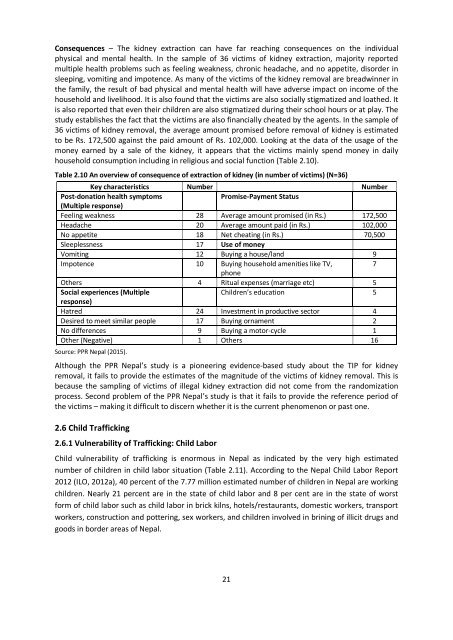TRAFFICKING IN PERSONS
397604438Trafficking_in_Persons_National_Report_2013-15
397604438Trafficking_in_Persons_National_Report_2013-15
Create successful ePaper yourself
Turn your PDF publications into a flip-book with our unique Google optimized e-Paper software.
Table 2.12 Percentage of married population by age and sex, decennial population censuses, 1961-2011,<br />
Nepal<br />
Census<br />
Male<br />
Female<br />
year<br />
6-9 10-14 15-19 6-9 10-14 15-19<br />
1961 2.97 10.59 35.86 5.29 24.64 71.42<br />
1971 1.20 6.23 26.62 2.33 13.36 60.19<br />
1981 - 14.03 25.09 - 13.36 50.05<br />
1991 - 4.06 19.13 - 7.21 45.5<br />
2001 - 0.76 11.7 - 1.73 33.23<br />
2011 - 0.45 7.05 - 1.12 23.09<br />
Source: CBS, 2014 (Pop Monograph, Vol. 1 Population Dynamics).<br />
Note that the incidence of child/early marriage shows a sharp variation according to rural urban<br />
areas, from one-cultural group to another and from one district to another. Districts with the highest<br />
incidence of child marriage are Bajhang, Baitadi, Dadeldhura, Kapilbastu, Rautahat and Saptari. A<br />
study conducted among 1,200 married women below 24 years of age in these districts revealed that<br />
two-thirds of these women had already married before they attained their 18 th birthday. The<br />
average age at marriage was 16 years (cited in CCWB, 2015).<br />
Given the high magnitude of child marriage, there have been very few complaints registered in<br />
Nepal Police against child marriage. This may be mainly due to cultural acceptance of child marriage<br />
in Nepalese society and partly lack of awareness against child marriage. In FY, 2014/15, there were<br />
23 cases of child marriage registered in Nepal police. Out of these cases, there were 6 cases in<br />
eastern, 4 in central, 12 in mid-western and 1 in far-western development regions (CCWB, 2015).<br />
2.6.3 Vulnerability of Trafficking: Violence against Children<br />
There are several factors that led to vulnerability of trafficking of children, including lack of<br />
education, poverty, dysfunctional family, and occurrence of violence against children in the family<br />
and in the community. Informal Sector Service Center (<strong>IN</strong>SEC) collects and compiles data annually<br />
related with violation of human rights including child rights. In the 2013, a total of 715 children are<br />
reported to have victims of different crimes. Among the crime listed, rape, sexual abuse and child<br />
trafficking are noticeable. Of the 715 crime compiled, rape alone constituted of 57 percent, followed<br />
by sexual abuse (25.5%) and child trafficking (9%). This pattern also holds for the year of 2014 –<br />
suggesting that sexual exploitation, rape and trafficking are the major types of crime against children<br />
in Nepal (Table 2.13).<br />
One important insight from the <strong>IN</strong>SEC data is that there is a wide gap in number of victims of crime<br />
between boys and girls – an overwhelmingly majority of girls compared to boys are at risk of crime.<br />
This happens because almost all the cases of crime of rape, sexual abuse are of girls.<br />
23


